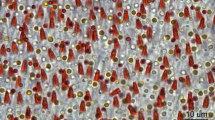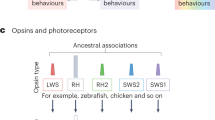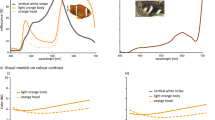Abstract
THE purpose of this study was to compare the optimum stimulus sizes of class 2 ganglion cells in Rana pipiens with those of R. catesbeiana. Several neurophysiological studies have suggested that activity in class 2 ganglion cells in the frog retina (convexity sensitive1–3) serves as a trigger for prey catching1,4. Field studies of the stomach contents of various species of frogs show that the prey selected by the bullfrog, R. catesbeiana, differs from that of the leopard frog, R. pipiens, in size. Bullfrog stomachs have contained (in addition to insects) crayfish, frogs, mice, and birds5,6. Leopard frogs generally prey on various insects, spiders, and terrestrial snails7,8. This study was undertaken to explore a possible difference in the electrophysiological optimal stimulus size for class 2 retinal ganglion cells of leopard frogs and bullfrogs which might be related to differences in prey size preference. Our data suggest that bullfrog ganglion cells have average optimal stimulus sizes significantly larger than those of leopard frogs.
This is a preview of subscription content, access via your institution
Access options
Subscribe to this journal
Receive 51 print issues and online access
$199.00 per year
only $3.90 per issue
Buy this article
- Purchase on Springer Link
- Instant access to full article PDF
Prices may be subject to local taxes which are calculated during checkout
Similar content being viewed by others
References
Lettvin, J. Y., Maturana, H. R., McCulloch, W. S., and Pitts, W. H., Proc. Inst. Radio Engrs, 47, 1940–1951 (1959).
Pomeranz, B., and Chung, S. H., Science, 170, 983–984 (1970); Pomeranz, B., Exp. Neurol., 34, 187–199 (1972).
Chung, S. H., Bliss, T. V. P., and Keating, M. J., Proc. R. Soc. B, 187, 421–447 (1974).
Pigarev, I. N., and Zenkin, G. M., Neurosci. Trans., 13, 29–33 (1970); Pigarev, I. N., Zenkin, G. M., and Girman, S. V., Neurosci. Behav. Physiol., 5, 325–330 (1972).
Howard, W. E., Copeia, 1950, 152 (1950); Cohen, N. W., and Howard, W. E., Copeia, 1958, 223–225 (1958).
Stewart, M. M., and Sandison, P., J. Herp., 6, 241–244 (1972).
Linzey, D. W., Herpetologica, 23, 11–17 (1967).
Whitaker, J. O., Herpetologica, 17, 173–179 (1961).
Maturana, H. R., Lettvin, J. Y., McCulloch, W. S., and Pitts, W. H., J. gen. Physiol., 43 (Suppl.), 129–175 (1960).
Gesteland, R. C., Howland, B., Lettvin, J. Y., and Pitts, W. H., Proc. Inst. Radio Engrs, 47, 1856–1862 (1959).
Gaze, R. M., Qu. Jl exp. Physiol., 43, 209–214 (1958).
Jacobsen, M., Qu. Jl exp. Physiol., 47, 170–178 (1962).
Butenandt, E., and Grüsser, O.-J., Pflügers Arch. ges. Physiol., 298, 283–293 (1968).
Jacobs, G. H., Brain Res., 14, 553–573 (1969).
Fite, K., Behav. Biol., 9, 707–718 (1973).
Ewert, J.-P., Brain Behav. Evol., 3, 36–56 (1970).
Ingle, D., Behav. Biol., 9, 485–491 (1973).
Heatwole, H., and Heatwole, A., Copeia, 1968, 692–698 (1968).
Ewert, J.-P., and Siefert, G., Vision Res., 14, 431–432 (1974).
Ewert, J.-P., and von Wietersheim, A., J. comp. Biol., 92, 131–148 (1974); Ewert, J.-P., and von Wietersheim, A., J. comp. Biol., 92, 149–160 (1974).
Ingle, D., Science, 180, 422–424 (1973).
Ingle, D., Brain Behav. Evol., 1, 500–518 (1968).
Author information
Authors and Affiliations
Rights and permissions
About this article
Cite this article
GLICKMAN, R., POMERANZ, B. Frog retinal ganglion cells show species differences in their optimal stimulus sizes. Nature 265, 51–53 (1977). https://doi.org/10.1038/265051a0
Received:
Accepted:
Issue Date:
DOI: https://doi.org/10.1038/265051a0
Comments
By submitting a comment you agree to abide by our Terms and Community Guidelines. If you find something abusive or that does not comply with our terms or guidelines please flag it as inappropriate.



